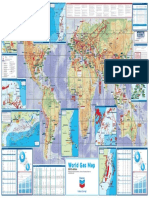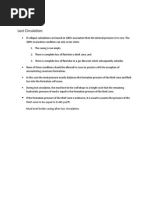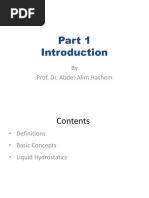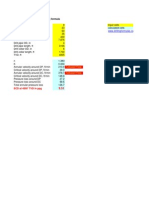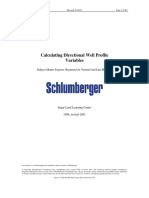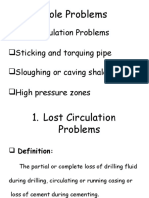Kick Handling With Losses in An HPHT Environment: Wild Well Control
Kick Handling With Losses in An HPHT Environment: Wild Well Control
Uploaded by
dexxterCopyright:
Available Formats
Kick Handling With Losses in An HPHT Environment: Wild Well Control
Kick Handling With Losses in An HPHT Environment: Wild Well Control
Uploaded by
dexxterOriginal Title
Copyright
Available Formats
Share this document
Did you find this document useful?
Is this content inappropriate?
Copyright:
Available Formats
Kick Handling With Losses in An HPHT Environment: Wild Well Control
Kick Handling With Losses in An HPHT Environment: Wild Well Control
Uploaded by
dexxterCopyright:
Available Formats
MANAGED
PRESSURE
DRILLING
In most High-Pressure, High-Temperature (HPHT)
wells, margins between fracture gradient, mud weight and
pore pressure are typically close, leading to loss of returns as
one of the most common complications in kick handling.
Operational and technical options for handling some typical
scenariosincluding simultaneous occurrence of losses and
influxare not unfamiliar to the industry, but application
of these measures in a logical sequence can help produce suc-
cessful outcomes. Case studies from HPHT wells illustrate
relevant issues, including applicable mitigations and contin-
gencies for well planning and drilling operations.
FRACTURE GRADIENTS IN SHALE AND SAND
It has been recognized for some time that, for a given depo-
sitional environment, Fracture Gradient (FG) in shale can be
appreciably higher than in sand. Such differences in FG have
long been applied to design of fracture stimulations, including
containment of such fracs within the sand body being simu-
lated. In recent years, there has been increasing recognition of
this difference in terms of well control, particularly in deep,
HPHT or deepwater drilling projects, where kick margins can
often be small and therefore critical.
An example from a typical deepwater project is seen in Fig.
1, which shows a difference of 0.51.0 pounds per gallon (ppg)
between the shale and sand fracture gradients in the deep sec-
tions below the base of salt at a depth of about 25,000 ft. It
is not unusual in this type of wells to find the hole unable to
hold a kick even though shut-in pressure is below the pressure to
which the casing shoe was tested. Since most casing shoes are set
in shale formation, this condition is likely caused by FG differ-
ence between the shale at the shoe and a sand formation in the
open hole, including the source sand of the kick in some cases.
When a kick is shut in, wellbore pressure charges up in a
mechanism similar to that of a leak-off test, such as shown in
Fig. 2. As long as pressures have not reached Formation Break-
Down (FBD) pressureat which point induced fractures will
open and propagatethe formation will recover and be able
to contain pressures below FBD. However, once FBD is ex-
ceeded, the formation can only hold its Fracture-Closing Pres-
sure (FCP), which is lower than FBD.
For the kick shown in Fig. 2, shut-in pressure is lower than
FG of the shale at the shoe, but is higher than that of the source
sand in the openhole section. In terms of kick containment,
the above mechanism means as long as Equivalent Mud Weight
(EMW) remains below 19.1 ppg, which is the sands FBD, the
hole can contain the pressures needed to shut in and circulate
the kick. There may be limited mud loss, and the sand may get
charged up to the kill mud weight used, but there should be no
massive losses. If FBD is exceeded by a higher shut-in pressure
or by bullheading, then the hole will only be able to contain an
EMW equal to the sand FCP of 18.8 ppg. Under these condi-
tions, induced fractures in the sand will open and close at about
the same pressure, resulting in a scenario where the hole loses
mud and flows at practically the same mud weight. In fact, bull-
heading is likely to charge up the sand with a reservoir pressure
equal to FCP, and the well can continue to lose and gain at the
same mud weight until most or all of the bullheaded volume is
flowed back, and the induced fractures can close up and heal.
KICKS WITH LOSSES
Following are two case histories of such simultaneous oc-
currence in an HPHT environment. Although depths and
other details have been modified with FG values that are
consistent with those shown in Fig. 2, the basic principles
involved remain unchanged. Since oil-based mud was used,
Kick handling with losses
in an HPHT environment
In HPHT or deepwater operations, differences in shale and sand fracture gradients
can result in kicks with simultaneous gains and losses. Options for handling
these scenarios are available, but must be applied in a logical sequence.
Fred Ng, Wild Well Control
8 9 11 10 12 13
Mud weight, ppg
T
V
D
,
f
t
14 15 16 17 18
35,000
30,000
25,000
20,000
15,000
Most likely pore pressure
Frac gradient
Overburden
Estimated sand FG
Estimated shale FG
10,000
Top of salt
Base of salt
8,638
25,525
5,000
Fig. 1. A difference of 0.51.0 ppg can be seen between the
estimated shale and sand fracture gradients below 25,000 ft.
MARCH 2009 World Oil
Originally appeared in:
March 2009 issue, pgs 49-52.
Posted with permission.
MANAGED PRESSURE DRILLING
downhole values of densities and gradients are important, as
well as Surface Mud Weight (SMW). Wherever appropriate,
downhole values of the leak-off test and Equivalent Static
Densities (ESDs) are referenced in these descriptions. All FGs
cited are based on downhole values.
The schematic in Fig. 3 shows that Operator As well took
a kick at 18,200 ft. Shut-in pressure and Kill Mud Weight
(KMW) were below the shale FG of 19.3 ppg at the shoe, but
exceeded the sand FG of 18.6 ppg. However, since pressures
did not exceed the sand FBD of 19.1 ppg, the kick was circu-
lated out with limited mud losses at 18.4 ppg SMW/18.6 ppg
ESD. One result is that the sand was charged to a reservoir
pressure equal to the KMW of 18.6 ppg. Subsequent drilling
experienced losses with the pump on at an Equivalent Cir-
culating Density (ECD) of over 19.1 ppg, and experienced
flow with the pump off at 18.4 ppg SMW/18.6 ppg ESD.
Since the well was still able to hold 18.8 ppg, well control
was maintained by keeping this EMW in the hole, which was
monitored with a pressure-while-drilling tool in the drillstring.
Pump rate was limited to control ECD while circulating, con-
nections where made while trapping over 200 psi using the
annular preventer, and trips were made while spotting heavy
pill on bottom. The well was drilled to a TD of over 20,000
ft, with the gas reading on the mud logs showing formation
pressure below the ESD of 18.6 ppg. The well was successfully
logged after spotting a heavy mud pill and POOH.
Figure 4 shows that Operator B took the same kick at 18,200
ft, under the same conditions. Instead of circulating out the
kick, the well was bullheaded with some 2,000 bbl of 18.4-ppg
mud. As a result, the sand was fractured and charged to its
FCP (equivalent to 18.8 ppg), thus creating a fractured reser-
voir that would lose and gain at about the same mud weight.
Drilling proceeded with continuous losses at ECD of over 18.8
ppg. Since the well would flow with the pump off at 18.4 ppg
SMW/18.6 ppg ESD, connections were made while continu-
ously pumping and with mud loss into the annulus, and no bit
trips could be made. By the time an 18,800-ft TD was reached,
the well had experienced a total mud loss of over 5,000 bbl,
and there were no easy alternatives to POOH for logs without
bleeding and circulating out most of this mud volume. Simula-
tions indicated that, based on shale FG limit at the shoe, such a
bleed-and-circulate operation would be limited to 120 bbl per
cycle at a pump rate of 1 bbl/min. Estimated rig time required
to complete this bleeding would be up to 45 days.
OPTIONS FOR HANDLING KICKS WITH LOSSES
Discussed below are some options for handling typical sce-
narios involving simultaneous occurrence of losses and influx.
Scenario 1: Hole holds at shut-in, attempt made to cir-
culate kick. If there was prior experience of loss in the hole sec-
tion, consider adding lost circulation material to the kill mud.
Establish the drillers method (a well-killing method involving
two circulations, one to circulate the formation fluids out of
the well and the other to circulate heavier mud through the
wellbore) at the slowest practical pump rate. If losses develop,
then shut down and restart the mud pumps at a reduced rate.
It may sometimes be necessary to use the Barrel-In Barrel-
Out (BIBO) method, which involves adjusting the choke
setting to establish a slow pump rate that results in no mud
loss or gain. Once the rate is thus established, note the pump
pressure at this point and keep it constant. Maintain this rate
until the influx is above the casing or liner shoe, at which time
a similar process can be used to step up the pump rate.
Scenario 2: Unable to establish stable kill rate. In cases
that involve simultaneous loss and gain, it is difficult to estab-
lish control, since effects of the two can mask each other. The
Took kick at 18,200 ft, bullheaded over
2,000 bbl of 18.4 ppg MW. Sand fraced
and charged to closing pressure,
creating a fractured reservoir with
loss/gain at 18.8 ppg EMW.
Drilled with loss at over 18.8 ECD, ow with pump
off at 18.4 ppg SMW/18.6 ppg ESD. Pumped for
connection. No trips.
At over 18,800 ft T0, tota| mud |oss over 5,000 bb|.
8a|sed Nw to 18.ppg SNw/18.8 ppg FS0,|oss/
gain unchanged at 18.8 ppg EMW. Unable to POOH.
Nax|mum a||owab|e annu|us surface pressure for
casing limits bleed and circulate to 120 bbl per
cycle at 1 bbl/min.
Fst|mated tota| t|me needed: over 45 days.
Shoe at 18,000 ft, 19.3 ppg (downhole
value of leakoff test).
Fig. 4. Simultaneous kick and loss experienced by Operator B.
Shoe at 18,000 ft, 19.3 ppg )downhole
value of leakoff test).
Took kick at 18,200 ft, killed with
limited losses at 18.4 ppg SMW/
18.6 ppg ESD. Sand charged to
18.6 ppg reservoir pressure.
Drilled to TD at over 20,000 ft+ with 18.4 ppg mud
weight. Gas reading showed formation pressure less
than ESD in hole section. Spotted heavy pill, POOH
for logs.
Loss w|th pump on at over 19.1 ppg F00, ow
with pump off at 18.4 ppg/18.6 ppg ESD.
Kept 18.8 ppg FNw at T0: L|m|ted F00, trapped
over 200 psi for connections, tripped with
heavy pill.
Fig. 3. Simultaneous kick and loss experienced by Operator A.
Volume
P
r
e
s
s
u
r
e
Shale FG at shoe: 19.3 ppg
Sand fracture closing
at 18.8 ppg (FCP)
Sand breakdown at 19.10 ppg (FBD)
Before frac
After frac
Sand FG at 18.6 ppg
Fig. 2. Effect of the differential between sand and shale FGs.
MARCH 2009 World Oil
WILD WELL CONTROL - MANAGED PRESSURE DRILLING
pit level in these situations can only indicate net change, but
not the effects of each individual occurrence. Attempting to
circulate under these conditions can result in large undetected
losses and/or influx.
It is important to resolve the two occurrences one at a time.
The priority in this scenario should be to cure losses with pills
and squeezes as needed. Wireline logs such as temperature,
noise, neutron (for gas/liquid differentiation) and stuck pipe
logs may be needed to diagnose flows and locate sources and
exit points in the annulus.
If the losses cannot be cured, an alternative is to stop the
influx by spotting one or more barite plugs. Pumping cement
is usually not advisable in the presence of gas, since it tends to
form a porous honeycomb that does not provide an effec-
tive seal. In some cases, it can set up enough to block needed
pumping access, but at the same time it fails to plug off the
influx. One drawback with barite plugs is that they are diffi-
cult to drill up, often resulting in unintended sidetracks when
the well is subsequently re-entered. It is usually advisable to
use specialists for these unconventional
well control operations.
Scenario 3: Hole does not hold
when kick is shut in. In this case, an
underground cross-flow may already be
occurring. Diagnostic and treatment op-
tions are similar to those in Scenario 2.
Sandwich kill is sometimes used,
but this method often has limited suc-
cess. Another option, dynamic kill, can
also have limited success, depending on
whether there is a long enough hole inter-
val between source and exit, the volume
of kill fluid, the pump rate and horse-
power required, and availability of high-
performance pumping equipment.
SIMULATION
Simulation of kick circulation can be
helpful for managing well control risks in
these situations. It can show pressure, vol-
ume and other parameters and trends for
a successful kick circulation, which pro-
vides guidance for diagnosis when actual
parameters deviate substantially from the
simulated results.
Most drilling professionals developed
their well control knowledge and experi-
ence in a Water-Based Mud (WBM) en-
vironment involving conventional depths
of 15,000 ft or less. Well control schools
also often base their tests and simulations
on the same type of wells. Since kick
handling is not a frequent occurrence for
most operations, parameter trends from
such conventional kicks tend to form the
basis for making well control decisions.
The above limitation can result in
problems when diagnosing and mak-
ing decisions with kicks involving deep,
HPHT or deepwater operations, par-
ticularly if oil- or Synthetic-Based Mud
(SBM) is used. Pressure, volume and
other parameter and trends for a successful kick circulation
in these wells can be very different than what might be in-
tuitively inferred from experience with conventional WBM
operations. Most of the effects are due to differences in com-
pressibility of diesel- or synthetic-based oil compared with
water, as well as differences in gas solubility in these fluids.
For example, Fig. 5 shows a simulation of circulating out a
120-bbl swabbed kick from 12,500 ft with WBM. Figure 6
show a simulation for a 100-bbl kick circulation from 20,700
ft in SBM. Even though both used drillers method circula-
tion, comparison of the Choke Pressure (CP) profiles for the
two cases show very different trends. The WBM case shows
CP at a maximum when gas reaches the surface, while the
trend is exactly reversed in the SBM case, with maximum CP
occurring at initial shut-in.
In a recent case, an operator took an 80-bbl kick at 27,000
ft while drilling in 7,000-ft water depth with 15.0-ppg SBM.
Initial Shut-In Casing Pressure (SICP) was 1,800 psi. Based
on the operators experience with conventional WBM op-
0
0
50
100
150
200
100 200
Time, min.
V
o
l
u
m
e
,
b
b
l
P
r
e
s
s
u
r
e
,
p
s
i
P
r
e
s
s
u
r
e
,
p
s
i
P
r
e
s
s
u
r
e
,
1
,
0
0
0
p
s
i
300 400 0
0
100
200
300
400
500
100 200
Time, min.
Pit gain
0
0
1
2
3
4
100 200
Time, min.
F
l
o
w
r
a
t
e
,
M
M
c
f
d
300 400
Gas owrate out
Pump pressure Free gas, vol.
Casing shoe and
fracture pressure
300 400
0
0
200
400
600
800
1,000
100 200
Time, min.
Choke pressure
300 400
0.00
13
12
11
10
9
8
7
6
5
4
3
2
1
0
0.10
Free gas, vol%
D
e
p
t
h
1
,
0
0
0
f
t
0.20
0
2.3
2.4
2.5
2.6
2.7
2.8
2.9
3.0
3.1
200
Time, min.
Casing
Closing
400
Annulus
Fig. 5. Simulation of circulating out a 120-bbl swabbed kick from 12,500 ft with WBM.
0
0
20
40
60
80
100
120
Time, min.
V
o
l
u
m
e
,
b
b
l
D
e
p
t
h
,
f
t
P
r
e
s
s
u
r
e
,
p
s
i
P
r
e
s
s
u
r
e
,
p
s
i
1,000
Pit gain
0
0
200
400
600
700
100
300
500
Time, min.
P
r
e
s
s
u
r
e
,
p
s
i
1,000
Pump pressure
0
13,700
6,400
6,600
6,800
7,000
7,200
7,400
7,600
7,800
8,000
8,200
8,400
8,600
8,800
9,000
9,200
13,800
13,900
14,000
14,100
14,200
14,300
14,400
Time, min.
1,000
Casing shoe
and fracture
pressure
0
Time, min.
1,000
Pressure at
observation
point
0.0
22,000
20,000
18,000
16,000
14,000
12,000
10,000
8,000
6,000
4,000
2,000
0
Dissolved gas, wgt%
0.8
Dissolved
gas (mass)
0
0
200
400
600
700
100
300
500
Time, min.
V
o
l
u
m
e
,
b
b
l
F
l
o
w
r
a
t
e
,
M
c
f
d
1,000 0
0
500
1,000
1,500
2,000
Time, min.
1,000
Choke
pressure
Gas owrate
out
Casing
Closing Annulus
Point 1
Point 2
Fig. 6. Simulation of circulating out a 100-bbl kick from 20,700 ft with SBM.
MARCH 2009 World Oil
WILD WELL CONTROL - MANAGED PRESSURE DRILLING
MANAGED PRESSURE DRILLING
erations, there was concern that CP might increase to over
10,000 psi when influx gas was circulated to the surface. Due
to this concern, the initial decision was to bullhead the in-
flux back into the formation. However, SICP in this case was
very close to the maximum allowable shut-in pressure for that
mud weight. Bullheading would have resulted in the undesir-
able conditions experienced by Operator B described above.
A simulation was ordered, and results were emailed to the
rig within an hour or so of the initial shut-in. These results
were similar to the CP profile seen in Fig. 6. This allowed the
operator to see that the worst pressure conditions had already
been contained by the casing shoe and at the surface upon ini-
tial shut-in of the kick, and to determine that the kick could
therefore be circulated out safely using the drillers method.
Due to the close FG margin and high choke-line friction in
the cold, deep water column, a very slow pump rate had to
be established using the BIBO method. The kick was subse-
quently circulated out with no further complications.
The choice of appropriate simulation software is, of course,
critical. The type of analysis described in this article requires a
complete two-phase flow transient model, which includes fluid
compressibility, gas solubility, PVT algorithms, momentum,
energy, heat transfer, continuity, equations of state, rheology
and other effects. Besides real-time support for well control
events, these simulations are also useful for well control engi-
neering in designing well plans, and for evaluating kick toler-
ance limits in any hole section, such as shown in Fig. 7. Since
the model includes all occurrences that take place from the
pump to the end of the flare line, it is also useful for evaluating
a number of other well control aspects of well or rig design,
such as the capacity of the mud-gas separator system, or choke-
line friction for deepwater subsea BOP operations. WO
THE AUTHOR
Fred Ng is General Manager of Engineering at
Wild Well Control, Inc. He has over 25 years of ex-
perience in operational, technical and management
roles for major and independent operators. Dr. Ng
is a mechanical engineer by training, with a BS de-
gree with honors (rst class) from the University of
New South Wales, Australia, and MS and PhD de-
grees from Texas A&M University. He has taught
courses in mechanical engineering and petroleum
engineering at the University of Houston.
0.0
0 10 20 30 40 50
Kick size, bbl
Sec. A, 12-in. hole at 26,500 ft; 1178-in. shoe at 24,800 ft
with 16.4-ppg formation integrity test (downhole), drillers
method, 50-psi margin (Aug. 8, 2008)
16.21 pp
16.41 pp
16.06 pp
16.18 pp
16.37 pore
15.94 pp
15.80 ppg SMW/16.21 ppg ESD SBM,
50-gal/min. kill rate
15.45 ppg SMW/15.80 ppg ESD SBM,
200-gal/min. kill rate
15.80 pp
Pit 100 bbl
Gas 3.6 MMcfd
Choke 800 psi
60 70 80 90 100
0.1
0.2
0.3
K
i
c
k
i
n
t
e
n
s
i
t
y
,
p
p
g
0.4
0.5
0.6
pressure (pp)
Fig. 7. Simulation to evaluate kick tolerance limits for different
kill rates.
Article copyright 2009 by Gulf Publishing Company. All rights reserved. Printed in U.S.A.
Not to be distributed in electronic or printed form, or posted on a website, without express written permission of copyright holder.
WILD WELL CONTROL - MANAGED PRESSURE DRILLING
Wild Well Control, Inc.
Drilling Technology Center
2202 Oil Center Court
Houston, TX 77073
Tel: 1 (281) 784.4700
www.wildwell.com
You might also like
- European Platts 12 April 2024 FullDocument26 pagesEuropean Platts 12 April 2024 Fullliuheng1012No ratings yet
- Shutdown ListDocument5 pagesShutdown ListAnoop A.kNo ratings yet
- Iwcf Workbook Well Intervention Level 3 - 4Document169 pagesIwcf Workbook Well Intervention Level 3 - 4Ahmed Ali71% (7)
- Bit Hydraulic e CD CalculatorDocument1 pageBit Hydraulic e CD CalculatorJeffrey HoNo ratings yet
- World Gas Map 2015Document1 pageWorld Gas Map 2015IBHWANGNo ratings yet
- Marjan Oil Field DevelopmentDocument3 pagesMarjan Oil Field Developmentsureshmechanical86No ratings yet
- Forecast For US Oil and Gas Production (Laherrère & Hall 2018)Document24 pagesForecast For US Oil and Gas Production (Laherrère & Hall 2018)Cliffhanger100% (3)
- NGL PlantsDocument47 pagesNGL PlantsHassan Badri100% (3)
- Kick Handling Losses HPHT EnvironmentDocument4 pagesKick Handling Losses HPHT EnvironmentrajkumarfNo ratings yet
- Dynamic and Momentum KillingDocument20 pagesDynamic and Momentum Killingمصطفى مجدي100% (1)
- Rock Blasting: A Practical Treatise on the Means Employed in Blasting Rocks for Industrial PurposesFrom EverandRock Blasting: A Practical Treatise on the Means Employed in Blasting Rocks for Industrial PurposesNo ratings yet
- Critical RPM To Avoid Excessive Vibration 8Document3 pagesCritical RPM To Avoid Excessive Vibration 8Shafiqa Alhobaishy100% (1)
- Quick Guide:: in The Name of GODDocument4 pagesQuick Guide:: in The Name of GODpaiman100% (1)
- Schubert IADC WC ConferenceDocument31 pagesSchubert IADC WC ConferenceNekyneky NekyNo ratings yet
- Section - 15 PIPE STUCKDocument10 pagesSection - 15 PIPE STUCKIbrahim DewaliNo ratings yet
- #3 Perhitungan Well Control #1 & #2Document5 pages#3 Perhitungan Well Control #1 & #2Fahrul mahanggiNo ratings yet
- Stuck Pipe/Tight Pipe Incident Reporting Form: Page 1 of 2Document2 pagesStuck Pipe/Tight Pipe Incident Reporting Form: Page 1 of 2David OrtegaNo ratings yet
- Lost Circulation:: Thief Zone To Be Equal To 0.465 Psi/ft. Mud Level Inside Casing After Loss CirculationDocument22 pagesLost Circulation:: Thief Zone To Be Equal To 0.465 Psi/ft. Mud Level Inside Casing After Loss CirculationbeautybdNo ratings yet
- Benchmarking Deep Drill and CompletionTechDocument4 pagesBenchmarking Deep Drill and CompletionTechRanchRoadNo ratings yet
- 5 RheologyDocument77 pages5 RheologyTamer Hesham AhmedNo ratings yet
- Drilling Pressure Control ExcercisesDocument18 pagesDrilling Pressure Control ExcercisesnjileoNo ratings yet
- Module 01 - Basic PressureDocument13 pagesModule 01 - Basic PressureLismi LismiNo ratings yet
- Part 2 Gas Behavior and HydrostaticsDocument55 pagesPart 2 Gas Behavior and Hydrostaticsahmedhussien1No ratings yet
- Mud Engineer Daily ChecklistDocument1 pageMud Engineer Daily ChecklistMohamed AbozeimaNo ratings yet
- Game Plan Adc-12 at Shyb-479 16" Hole 06/20/2014Document2 pagesGame Plan Adc-12 at Shyb-479 16" Hole 06/20/2014Mohamed AbozeimaNo ratings yet
- Aade 06 DF Ho 16Document9 pagesAade 06 DF Ho 16Khalizatul Kasim100% (1)
- Part 1 IntroductionDocument30 pagesPart 1 Introductionahmedhussien1No ratings yet
- Terminology and FormlaeDocument7 pagesTerminology and FormlaenabiNo ratings yet
- Preventing Differential Sticking and Mud Losses in Highly Depleted SandsDocument10 pagesPreventing Differential Sticking and Mud Losses in Highly Depleted SandsAry RachmanNo ratings yet
- Varel Hydraulic Data: Company Well Name & NumberDocument6 pagesVarel Hydraulic Data: Company Well Name & Numberalexis salazarNo ratings yet
- MUD IPFEST2020 Universitas Pertamina Final Report StriatureDocument23 pagesMUD IPFEST2020 Universitas Pertamina Final Report StriatureWahyu AndrionNo ratings yet
- E Hydraulics Optimization TheoryDocument24 pagesE Hydraulics Optimization TheoryjalalNo ratings yet
- Execution PlanDocument6 pagesExecution PlanHarold AldayNo ratings yet
- Slip Stick Delay Equations of Drill String Dynamics PosterDocument1 pageSlip Stick Delay Equations of Drill String Dynamics Postersaa6383No ratings yet
- Drilling Supervisory Questions AnsweredDocument280 pagesDrilling Supervisory Questions AnsweredKarrar SaleemNo ratings yet
- NLOG GS PUB 1387 Cementing EOWRDocument61 pagesNLOG GS PUB 1387 Cementing EOWRWilson WanNo ratings yet
- Daily Drilling Report N 33 TP181 AT-38 LE 03-10-2023Document3 pagesDaily Drilling Report N 33 TP181 AT-38 LE 03-10-2023karimamahboub88No ratings yet
- Optimization of FLOPRO NT Reservoir Drill-In FluidDocument6 pagesOptimization of FLOPRO NT Reservoir Drill-In FluidAhmer AkhlaqueNo ratings yet
- UL G 9-46 Unit #2H WBD PDFDocument7 pagesUL G 9-46 Unit #2H WBD PDFMilad Ebrahimi DastgerdiNo ratings yet
- Pressure Test That Is Typically Carried Out After Drilling Out Casing/cement, Prior To Drilling The Next Hole SectionDocument11 pagesPressure Test That Is Typically Carried Out After Drilling Out Casing/cement, Prior To Drilling The Next Hole Sectiondeyaa SadoonNo ratings yet
- Caculate Ecd With Engineering Formula 1Document2 pagesCaculate Ecd With Engineering Formula 1NurJan AmAnovNo ratings yet
- BallooningDocument3 pagesBallooningR.GNo ratings yet
- AEC DynamicsNewDocument42 pagesAEC DynamicsNewMuhammad Hamdy100% (1)
- Aramco Questionair Rev PDFDocument16 pagesAramco Questionair Rev PDFnabil heddadNo ratings yet
- Ballooning EffectDocument11 pagesBallooning EffectHamdi SaidNo ratings yet
- Equivalent Circulating Density With Engineering FormulaDocument2 pagesEquivalent Circulating Density With Engineering FormulaFlorina PrisacaruNo ratings yet
- Problems PDFDocument21 pagesProblems PDFTamlomNo ratings yet
- Tally Well 6g-0102a R-InjDocument7 pagesTally Well 6g-0102a R-InjLinheris Sitompul100% (1)
- Key PointsDocument3 pagesKey Pointssanjeet giriNo ratings yet
- Mud PlanDocument6 pagesMud PlanHarjan Philipp C. GopaldasNo ratings yet
- Mud Property WBM Testing Osvaldo Ndonga 2019Document69 pagesMud Property WBM Testing Osvaldo Ndonga 2019EzioSilvestre0% (1)
- Calc Dir WellDocument90 pagesCalc Dir WellSaul Pimentel100% (1)
- Pressure Qualitative: AssessmentDocument13 pagesPressure Qualitative: AssessmentLeidy TarquiNo ratings yet
- Modeling of Transient Cuttings TransportDocument11 pagesModeling of Transient Cuttings Transportmohamadi42No ratings yet
- Hole ProblemsDocument53 pagesHole ProblemsMohamed HashemNo ratings yet
- Cuttings TransportDocument10 pagesCuttings TransportHicham HichamNo ratings yet
- Drilling Fluid TestingDocument30 pagesDrilling Fluid Testingjonny mars100% (1)
- Kick Tolerance Misconceptions Spe-140113-Ms-pDocument10 pagesKick Tolerance Misconceptions Spe-140113-Ms-pDiego Araque100% (2)
- Kicks IndicatorsDocument17 pagesKicks IndicatorsGhavban DavidNo ratings yet
- Review W AnsDocument8 pagesReview W Ansjoaomayrink2100% (1)
- Post Job Report: Aminex Petroleum CompanyDocument12 pagesPost Job Report: Aminex Petroleum CompanyaliNo ratings yet
- Dynamic Low Choke High Quality PDFDocument4 pagesDynamic Low Choke High Quality PDFWCGNo ratings yet
- أسئلة للحفرDocument6 pagesأسئلة للحفرMalk7192100% (1)
- (2018) A New Drilling Performance Benchmarking - ROP Indexing MethodologyDocument12 pages(2018) A New Drilling Performance Benchmarking - ROP Indexing MethodologyRoger Guevara100% (1)
- Kill Sheet: Prerecorded Infromation Pump Strokes RequiredDocument16 pagesKill Sheet: Prerecorded Infromation Pump Strokes RequiredAbdul Hameed OmarNo ratings yet
- 08 Well ProblemsDocument47 pages08 Well ProblemsHossam Hussain HamoudaNo ratings yet
- CPC 21-26 Distribution ListDocument10 pagesCPC 21-26 Distribution ListMahesh Liyanage100% (2)
- Petronas Rapid Project Nur Syaira A19be0200 3sbeqDocument1 pagePetronas Rapid Project Nur Syaira A19be0200 3sbeqsyaira zukiNo ratings yet
- Glossary: Word Traduction Sentence Picture 1 Well Pozo The Workers Are Drilling The WellDocument7 pagesGlossary: Word Traduction Sentence Picture 1 Well Pozo The Workers Are Drilling The WellGalleta AvalosNo ratings yet
- 2012 PetroSkills Exploration&Production Training GuideDocument92 pages2012 PetroSkills Exploration&Production Training Guidepetro_man448444No ratings yet
- Activity: - Repeat Pass: 1600-1690 MMDDocument1 pageActivity: - Repeat Pass: 1600-1690 MMDNaisee KilLNo ratings yet
- Ketan Upadhyay CV 2024Document3 pagesKetan Upadhyay CV 2024anil yadavNo ratings yet
- Letourneau IncDocument12 pagesLetourneau IncArun SanthakumaranNo ratings yet
- Oil and Gas Production An Introduction To Oil and Gas Production 2 ND Edition 2018Document8 pagesOil and Gas Production An Introduction To Oil and Gas Production 2 ND Edition 2018osamaNo ratings yet
- Floating SystemDocument6 pagesFloating SystemKeneth Del CarmenNo ratings yet
- Directional Drilling For Enhanced Oil RecoveryDocument26 pagesDirectional Drilling For Enhanced Oil Recoveryknorhan38No ratings yet
- Petrolifera PetroleumDocument2 pagesPetrolifera PetroleumХристинаГулеваNo ratings yet
- Cover Letter Muhammad Tamoor MalikDocument1 pageCover Letter Muhammad Tamoor MalikMuhammad Tamoor MalikNo ratings yet
- 1 SKK Migas Deputi P20191010 AspermigasDocument12 pages1 SKK Migas Deputi P20191010 AspermigasIrsyad Saiful M.No ratings yet
- 2013 Adipec 687Document22 pages2013 Adipec 687Эльхан ИмановNo ratings yet
- Distribution and Production of Petroleum in The WorldDocument7 pagesDistribution and Production of Petroleum in The WorldLalrinmawia FanaiNo ratings yet
- Harga Batubara Acuan (Hba) & Harga Patokan Batubara (HPB) September 2019Document8 pagesHarga Batubara Acuan (Hba) & Harga Patokan Batubara (HPB) September 2019Adnan NstNo ratings yet
- Current Issue On LPG and Naphtha PricesDocument3 pagesCurrent Issue On LPG and Naphtha PricesJoefrizalJoefrizalNo ratings yet
- SE KG 1 1 Intervention Program FINAL Signed SLB SE FULLDocument78 pagesSE KG 1 1 Intervention Program FINAL Signed SLB SE FULLanes banjar100% (1)
- Methanol To Gasoline - ExxonMobil EnglishDocument17 pagesMethanol To Gasoline - ExxonMobil EnglishilhancatakNo ratings yet
- Pertamina EP Asset 4 Poleng BW-021 WO ProgramDocument12 pagesPertamina EP Asset 4 Poleng BW-021 WO ProgramDeddy BramNo ratings yet
- UOP Olefin Production Solutions BrochureDocument2 pagesUOP Olefin Production Solutions BrochureAbhik Banerjee100% (1)
- 3, Kawran Bazar, Dhaka-1215: 113 3760 3033.0 10552.3 80.7 100.0 Grand Total (1+2+3+4+5)Document9 pages3, Kawran Bazar, Dhaka-1215: 113 3760 3033.0 10552.3 80.7 100.0 Grand Total (1+2+3+4+5)Shuvro KunduNo ratings yet
- 3 Years After BP Blast, Big Oil Busy in The GulfDocument6 pages3 Years After BP Blast, Big Oil Busy in The GulfPham Thi Diem PhuongNo ratings yet




